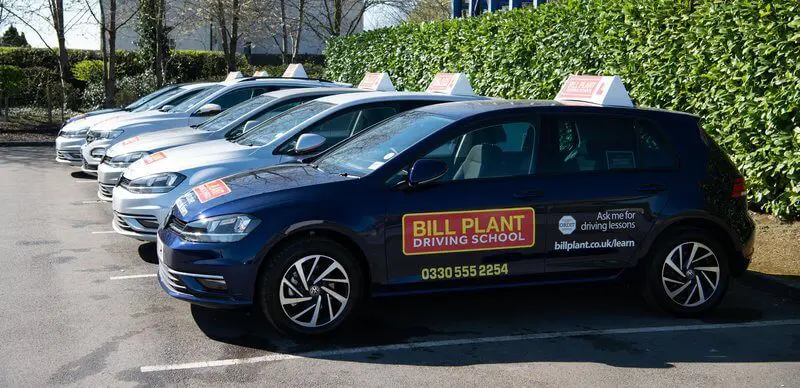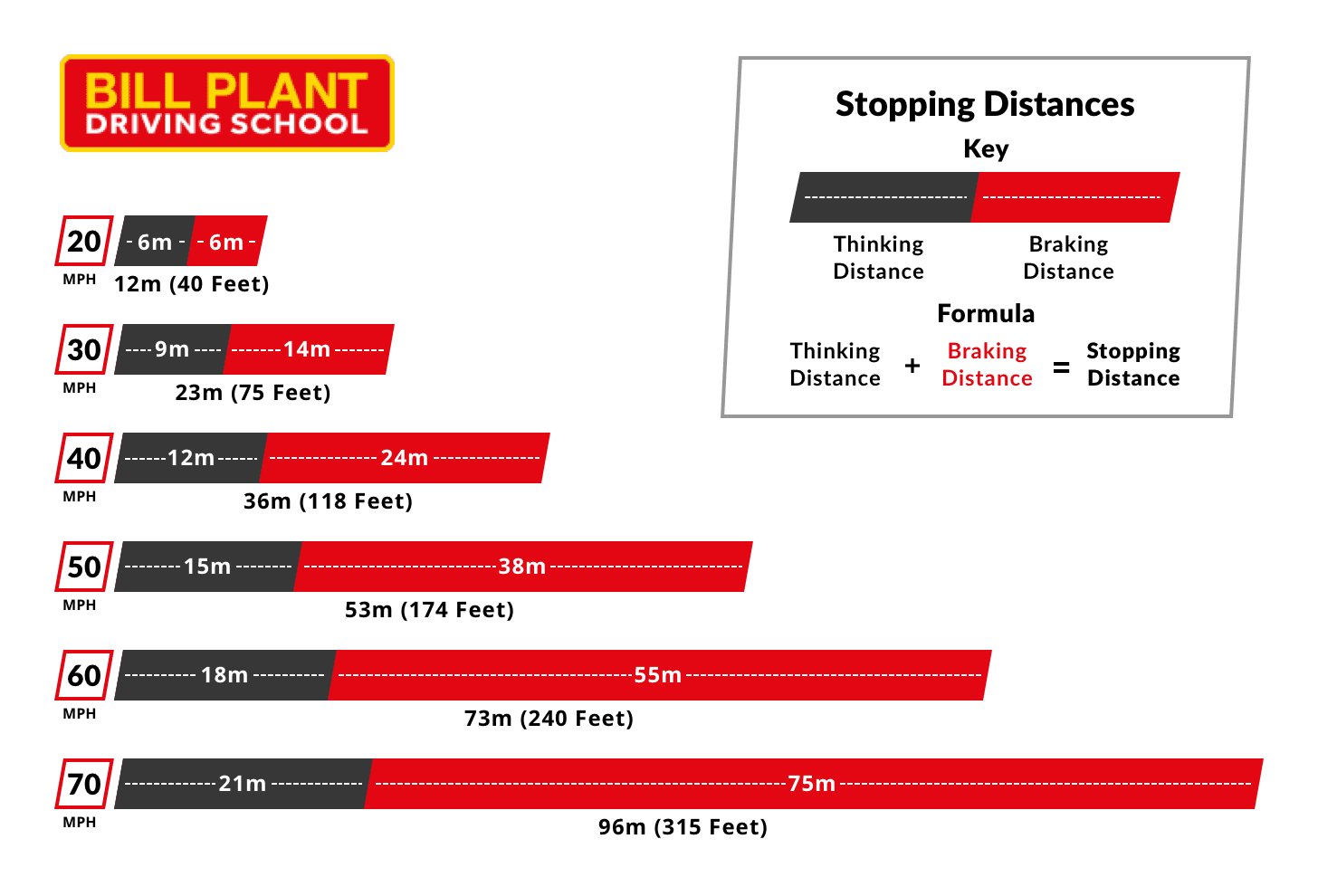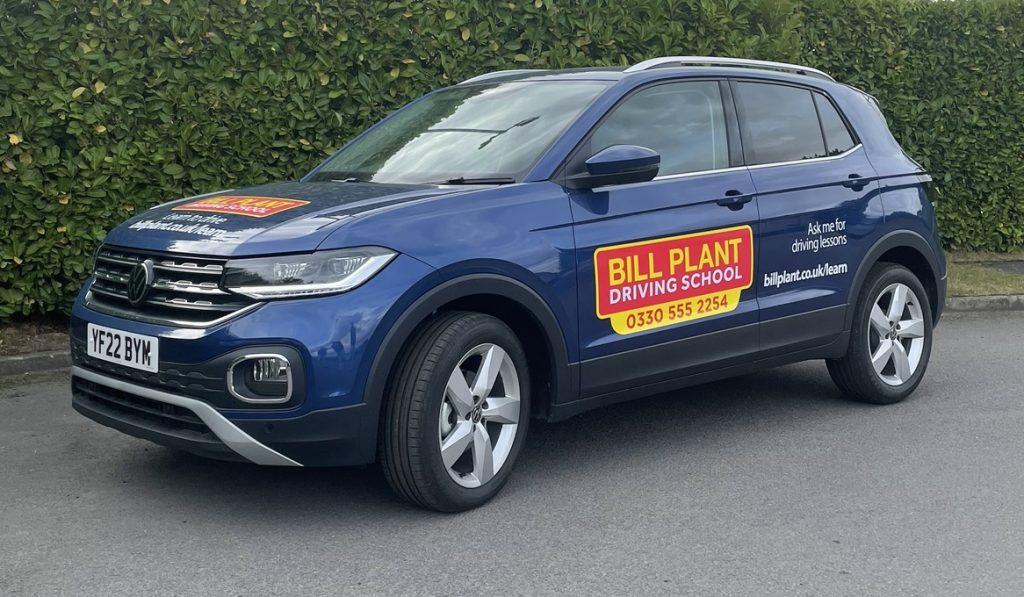
When driving any vehicle in any weather conditions, you need to know the safe stopping distances for the different speeds that you are likely to be travelling at. This helps both you and other road users stay safe on the roads. You will also need to know these distances to pass your Theory Test.
We have tried to break this information down for you into manageable bitesize chunks that you can understand and be confident in the knowledge that you know & understand the stopping distances involved in nearly all scenarios that you may well be likely to face as a driver.
What Does Stopping Distances Mean?
Many learner drivers – and experienced drivers – can often confuse the difference between braking distance and stopping distance. Stopping distance is the total time it takes for your vehicle to stop from the moment you see a hazard or brake lights ahead of you. This includes both braking distance and thinking distance.
Stopping Distance Formula
Thinking Distance + Braking Distance = Stopping Distance
Stopping Distance at 20 MPH
Thinking Distance – 6m (20 ft) + Braking Distance – 6m (20 ft) = Stopping Distance – 12m (40 ft)
Stopping Distance at 30 MPH
Thinking Distance – 9m (30 ft) + Braking Distance – 14m (45 ft) = Stopping Distance – 23m (75 ft)
Stopping Distance at 40 MPH
Thinking Distance – 12m (40 ft) + Braking Distance – 24m (78 ft) = Stopping Distance – 36m (118 ft)
Stopping Distance at 50 MPH
Thinking Distance – 15m (49 ft) + Braking Distance – 38m (125 ft) = Stopping Distance – 53m (174 ft)
Stopping Distance at 60 MPH
Thinking Distance – 18m (60 ft) + Braking Distance – 55m (180 ft) = Stopping Distance – 73m (240 ft)
Stopping Distance at 70 MPH
Thinking Distance – 21m (69 ft) + Braking Distance – 75m (246 ft) = Stopping Distance – 96m (315 ft)

What is Thinking Distance?
Thinking distance is the distance your vehicle will travel between you seeing a hazard ahead of you and pressing the brake pedal. Regardless of your speed, it is impossible to apply your brakes at the exact same time as the car in front. You must apply time to react to the situation and allow your feet to move across to the brake pedal.
Factors Affecting Thinking Distance
Speed
Naturally, the faster your car is travelling at the point you see a hazard, the further you will travel with the same reaction time compared to slower travelling speed. This is why leaving a sensible gap is important, especially at higher speeds.
Distractions
There may be a number of possible distractions inside and outside of the vehicle which could distract your attention and greatly increase your thinking distance. These could be other people in the car, the radio, other road users or pedestrians. It is vital you stay focused and in control of the vehicle at all times.
Tiredness
Tiredness can kill, take a break.
We have all seen the signs on motorways warning drivers of the dangers from being tired at the wheel. Tiredness can influence drivers attention, awareness of issues and reaction times to situations developing in front of them.
On longer journeys, it is recommended you take a break every couple of hours to avoid becoming overly relaxed and tired at the wheel.
What is Braking Distance?
Braking distance is the time it takes your vehicle to stop from the moment you hit the brake pedal. This is the second part of your overall stopping distance and follows your thinking distance.
Factors Affecting Braking Distance
Car Condition
The condition of your vehicle will also play a huge part in the effectiveness of stopping your vehicle. The condition of your tyres and brakes are important to your braking distance. Having excessively worn tyres can increase braking distance by up to 40%.
It is essential these are regularly checked and maintained. This is why we regularly check all Bill Plant tuition vehicles and replace parts and even the cars when necessary.
Weight in the Car
Due to the momentum generated from travelling at speed, a heavier car is harder to stop than a lighter car. While your thinking distance should be the same regardless of vehicle weight, your braking distance will increase leading to longer overall stopping distances.
Road Condition
Poorly maintained roads will make it harder to stop your vehicle. Loose elements such as gravel will provide little resistance to stop you moving forward, as will mud and dirt. These restrict the contact between tyres and a solid surface, limiting grip and ability to stop.
Stopping Distances in Weather Conditions
Stopping Distances in Rain
When driving in wet conditions or in rain the Highway Code advises your total stopping distance will be at least double the distance to stop on a dry surface.
There are two main reasons for this. The first being a wet road surface will be more slippery creating less tyre grip to the road and increasing braking distance. Additionally, adverse weather conditions such as heavy rain can drastically reduce visibility on roads, this is likely to increase your reaction time before braking.
Stopping Distances on Ice
When driving in conditions of ice and snow the Highway Code advises your braking distance could be TEN TIMES higher than on a dry road.
This means the equation for stopping in icy weather is:
Thinking Distance + (Stopping Distance x10) = Total Stopping Distance
That means if you are travelling at 70 MPH on an icy road it could take you up to 771m to stop your car. That is the equivalent of half a mile or the length of 8 football pitches.
Two Second Gap Rule
When driving, the general rule is to leave a two-second gap between you and the vehicle in front, however, varying driving conditions can play havoc with this guesswork and leave you and others in danger.
If you are currently taking driving lessons, the chances are your instructor will have mentioned the two-second rule at some point. The easiest way to check this is to identify a landmark on the side of the road, potentially a tree or road sign. Count the time taken from the car in front passing this point until the point when you pass this. Two seconds is the minimum recommended and serves at any speed – remember, over two seconds is always better than less.
Want to learn to drive with an award winning driving school?
Book your driving lessons online today. Simply put your location into our instructor finder tool and we can put you in touch with your local Driving Instructor.
Many of our instructors offer individual block booking discounts! (Subject to area and availability)

